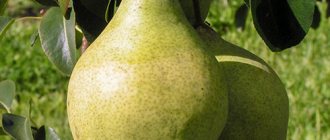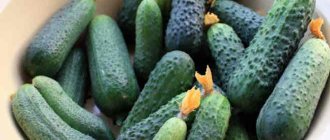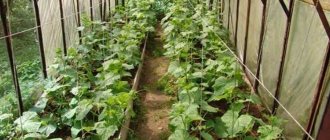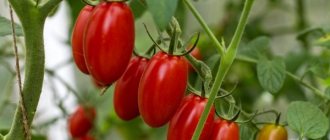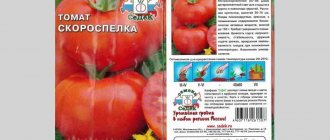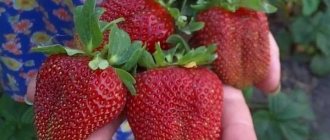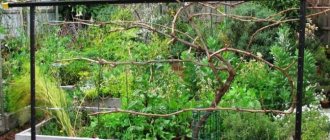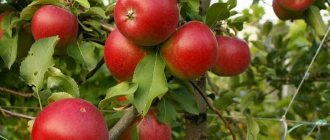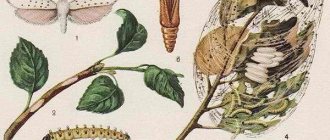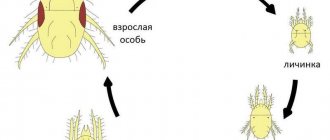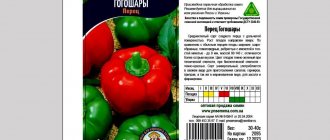The variety is late-winter, quite stable, vigorous, frost-resistant, and is approved for cultivation in many regions.
Map. Regions where the variety will reveal its qualities to the maximum
Advantages and disadvantages
The main advantages of the Sinap Orlovsky variety:
- precociousness;
- excellent winter hardiness;
- excellent taste of apples;
- possibility of long-term storage.
Orlovsky is considered a partially self-fertile variety. However, if other varieties are planted on the site, this has a positive effect on its yield - it is much higher.
- large size of trees;
- If there is a calcium deficiency in the soil, the fruits may suffer from bitter pitting.
These and other features, planting and cultivation, characteristics of fruits and reviews of gardeners about the variety will be discussed further.
Appearance
Apple trees have a spreading crown and strong branches. The leaf blades are large, dark green. Foliage, sitting on short petioles, is located on the branches quite rarely. During the flowering period, the tree branches are decorated with beautiful light pink flowers.
Tasting assessment and description of fruits
Distinctive features characteristic of the fruits of the Sinap Orlovsky apple tree variety:
- attractive round-conical, often oblong (synapoid) shape - when ripening, some of the fruits become rounded;
- dense shiny skin.
In different years and on different soils, the apple acquires a stronger or less colored pink side.
The seeds are small and brown in color.
There are removable and consumer ripeness of fruits:
- The ripeness of the fruits of this winter variety, like the Orlovsky Partizan apple tree, occurs at the end of September. At this time, growth processes stop and fruit can be collected.
- The fruits reach consumer ripeness in November. During this period, apples acquire the taste and aroma inherent to the variety.
In the stage of removable ripeness, apples have a pleasant yellowish-green color, which becomes golden yellow during the onset of consumer ripeness (during storage). From the side illuminated by the sun, a blurry blush appears on the fruit.
The flesh of the apples is greenish-cream and very juicy. Characteristic features of apple pulp:
- pleasant aroma;
- optimal balance of acid and sugar.
The fruit size is larger than average. Just like the Oryol striped apple tree, their weight reaches 120-150 g. The largest fruits weigh up to 200 g.
During consumer ripeness, that is, from the beginning of November and almost until the beginning of May, apples are perfectly stored without reducing the quality of the fruit. Experts estimate the external attractiveness of apples of this variety at 4.3 points, and the taste of the fruit received an equally high score - 4.4–4.7.
Features of fruiting and productivity
The variety is early-bearing - fruiting occurs when the trees are 4-5 years old. Productivity is annual, without periodicity. In this regard, the variety wins in comparison with the same Antonovka.
This is interesting! The trees have good productivity and regularly bear fruit both at a young and mature age. The average yield is from 50 to 80 kg per tree. With proper care, you can harvest 130-150 kg or more. This figure significantly exceeds the yield of such apple tree varieties as Oryol Polesie.
Winter hardiness and disease resistance
The variety belongs to the winter-hardy group. Mature trees are able to withstand frosty winters, and this does not affect the future harvest in any way. Therefore, the variety is grown not only in the recommended areas, but also in the northern regions. In severe frosts, it is better to cover the trunks of young trees.
Apple trees demonstrate high resistance to many diseases. There is average resistance to scab and powdery mildew. Apple tree diseases and pests should be combated using fungicides and insecticides. As a preventive measure, in early spring they are treated with 1% Bordeaux mixture.
Important! A special feature of this variety is its increased need for calcium. If there is a deficiency of this microelement in the soil, the fruits show signs of bitter pitting. Heavy soils contain more calcium than sandy soils. To compensate for its deficiency, liming of the soil is used.
Description of the variety: Northern and Oryol Sinap
Northern Sinap was obtained by S. I. Isaev at the biological station for young naturalists named after K. A. Timiryazev by free pollination from the seeds of the Kandil-Kitaika variety in 1927. The variety grows safely in the territories of the Central Black Earth and Lower Volga regions, as well as in the stale form in regions of Eastern Siberia . It is popular not only in private gardens, but also in industrial gardens.
Oryol Sinap is a direct descendant of Northern Sinap and is not inferior to it in terms of yield and taste of fruits. Bred in 1955 at the All-Russian Research Institute for Breeding Fruit Crops and the All-Union Research Institute of Horticulture named after. I.V. Michurin by crossing Northern Sinap and the Pamyati Michurin variety. for state testing in 1979, and in 1989 it was zoned in the Central, Central Black Earth, Middle Volga and North-Western regions of Russia, as well as in six regions of Belarus .
Tree
The trees of both varieties are vigorous, large in size, with a pyramidal crown and spreading branches, so before planting them in a summer cottage, you should take care to allocate sufficient territory for the seedlings. Only in this way will a young tree grow and develop in comfortable conditions, receive the necessary amount of sunlight and produce rich harvests. The height of an adult tree reaches 5 meters, and when grown on a dwarf rootstock - 3 m.
Despite its massiveness, the main branches of the tree are sparsely spaced, so the crown does not become dense. This makes both care and subsequent harvesting easier.
The shoots are dark brown, of medium thickness, pubescent, geniculate, with sparsely spaced leaves. The type of fruiting is mixed: on simple and complex ringlets, twigs and on annual shoots. The leaves are green or dark green, medium in size, wide, elongated, heavily pubescent. The edge of the leaf blade is raised.
The main branches extend from the trunk at right angles, the ends of the branches are directed upward
In spring, trees become a real decoration of the garden thanks to large fragrant flowers of a delicate light pink color.
The blossoming of the Sinap apple tree will not leave any gardener indifferent
Apples
The apples of Sinap Orlovsky are medium in size, usually weighing up to 150 g. During the harvesting period, the color of the fruit is yellow-green, and after a short storage it becomes golden-yellow. On the sunny side, a diffuse pale pink blush may appear. The skin is dense, the surface is smooth with an oily tint. The fruits are the same size, round in shape with a sweet and sour taste and juicy fine-grained pulp .
From the sunny side, the apples of Oryol Sinap can become covered with a gentle, uniform blush, which gives them a special decorative effect.
Northern Sinap is not distinguished by the uniformity of fruit shape; its maximum weight usually does not exceed 120 g . The skin is smooth and becomes oily during storage. The color is yellow-green with a dark red blush. The pulp is juicy, loose, the taste is sweet and sour .
At the ripening stage, the skin of the fruits of Northern Sinap has a yellow-green color with a one-sided solid brown blush, and after being picked from the tree the fruits turn yellow
The pulp of apples has an excellent taste due to the harmonious combination of acid and sweetness, juiciness and delicate aroma.
Fruit maturity occurs after a month of storage after harvesting.
These apples contain a lower percentage of sugars compared, for example, to the Granny Smith variety. The total sugar content is less than 9.5%. After final ripening in storage, the ratio of sugars and acids becomes more balanced and the fruits acquire a rich taste with a slight sourness. The calorie content of 100 g of apples does not exceed 50 kcal.
The apples of Sinap Orlovsky are slightly larger than the fruits of Sinap Northern
Apples are very beneficial for the human body, as they contain a large amount of vitamins and microelements. Late winter varieties, which include Sinap, are especially valued because they are stored for a long time and do not lose their properties .
These apples are great for making preserves, compotes, and jams. They can be baked in the oven and eaten fresh. Also, the fruits of Oryol and Northern Sinap are used to prepare hypoallergenic children's juices and purees.
These apples make a very tasty homemade compote.
Breeding history
Sinap is the common name of a large group of apple varieties. There are about ten of them. They originate from the Crimean Sinap, known since the 19th century: Kandil-Sinapa, Sary-Sinapa.
This apple, the “Crimean miracle,” was proudly served by Russian aristocrats. From Crimea, the fruits were sent to Paris to return to Russia with exquisite French fruits.
Growing these apple trees required a lot of work from the very first day of planting. There were special family agronomic techniques that were kept strictly secret and passed down from generation to generation by Tatar gardeners. And synaps began to bear fruit only at the age of 10-15 years.
Nationalization of the land, civil war, deportation of the Crimean Tatars and collectivization by the end of the 30s almost completely destroyed the variety. The old gardens died, and there was no one to grow new ones...
Since 1922, I. Michurin began breeding frost-resistant Crimean apple trees. In 1927, this “magician from Kozlov” sent scientists at the Moscow Biological Station the seeds of the Kandil-Kitaika he bred to create a winter-hardy apple variety for long-term storage. The famous breeder S.I. Isaev gave birth to the “king” of Russian gardening - the Northern Sinap.
After 20 years of state testing, in 1959, the variety was included in the State Register.
Northern Sinap is a donor of new generations of valuable varieties of apples. On its basis, such popular varieties as:
- Almaty;
- Belorussian;
- Heroic;
- Mountain;
- Minusinsky;
- Orlovsky;
- Khakassian.
Phased selection made it possible to get rid of the shortcomings of the progenitor and increase its advantages.
Advantages and disadvantages
This variety is unpretentious in care, so it has many more advantages than disadvantages. Among the advantages of Sinap, it is necessary to note early fruiting, high yield, long-term storage of fruits and their excellent consumer qualities.
Oryol Sinap is more adapted to Siberian frosts, while Northern Sinap, despite the name and declared winter hardiness, is not recommended to be exposed to low temperatures and grown in the northern regions of our country. However, the slate molding, taking into account the protection and shelter of trees from the cold, still makes it possible to grow Northern Sinap in the regions of Eastern Siberia.
The Sinap apple tree has average resistance to scab, but, like many other varieties, it requires timely prevention and protection from pests and diseases. Disadvantages also include the massive size of the tree, which will be inconvenient for growing in private garden plots with a small area .
Application
In cooking
Apples are suitable for various processing; they are used to make compotes, preserves, syrup, juices, and dried. Apples are also used to make apple cider vinegar, apple wine, and make tinctures, liqueurs, and sweets.
When losing weight
Used in the form of single and mixed diets, fasting days.
In cosmetology
Masks, lotions, and rinses are prepared based on the fruits and juice.
Landing
In order for apple trees to produce a high-quality and regular harvest, it is important to provide care, which includes pruning, watering, fertilizing, and treating against pests and diseases. Then your apple orchard will delight you with tasty and healthy fruits for many years.
The most favorable time for planting seedlings of Oryol and Northern Sinap is considered to be the period from mid-September to mid-October. Planting in spring is also possible. In this case, it is carried out in the first ten days of April, after the threat of return frosts has completely passed.
Since the trees grow large, the distance between them should be 5–7 m.
The depth of each planting hole must be at least 80 cm, and the length and width must be at least 1 m. The holes should be prepared 2 weeks before planting. Broken brick or expanded clay is laid on the pre-loosened bottom to provide the tree with good drainage. The fertile soil from the pit is mixed with rotted manure and wood ash at the rate of ¼ fertilizer per ¾ of the land. 40 g of potassium sulfate and 80 g of superphosphate are added to this mixture. A third of the hole is filled with the resulting mixture, after which more soil is added to the center until a slide 20 cm high is formed.
Before planting a seedling in the ground, you should carefully inspect the roots, remove dry or damaged ones, and then place them in water for 4–5 hours to saturate them with moisture.
The seedling is placed in the hole so that the distance of the root collar to the ground is 5–6 cm. A peg 60–80 cm high is driven nearby, to which the young tree must be tied. The roots should be carefully straightened, covered with soil and lightly trampled. For watering, each seedling needs 3-4 buckets of water when planting.
The seedling is tied to a stake in one or two places
Loamy or sandy loam soil with good air and moisture permeability is suitable for planting seedlings. An important indicator will be the distance of the planting from the flow of groundwater by at least 2 m, since apple trees do not tolerate stagnant water.
The soil for planting Oryol Sinap must also contain a sufficient level of calcium in its composition, otherwise in the future its deficiency will adversely affect the taste of the fruit.
Where to buy seedlings?
The best seedling will be that grown in a similar climatic zone, preferably in the same region as the future place of growth. There are many options for purchasing seedlings. It can be:
- Exhibitions and sales of plants;
- Online stores with postal delivery;
- Private household plots;
- Official nurseries.
Preference should be given to the latter: the risk of receiving low-quality planting material and errors in the variety are practically eliminated! In addition, it is in official breeding stations and nurseries that you can learn about the true disadvantages and advantages of the variety, and the peculiarities of cultivation in the area.
It is better to purchase seedlings from official nurseries.
Many private breeders and official organizations send seedlings by mail. But no seller can guarantee that the seedling will not be damaged in transit or will not dry out.
The advantage of plant sales exhibitions is a huge selection of different varieties and seedlings. When purchasing apple trees, it is important to make sure that the seller did not grow them in warmer regions than your area. “Southern” trees do not adapt well to frost and may die in the first 2-3 winters.
Care
Sinap Orlovsky and Sinap Northern are unpretentious, but they require some attention. With proper care, the health of trees and fruits is maintained, and the quantity and quality of each harvest is increased.
Trimming
The intensive growth of these apple trees requires periodic pruning of branches. In the first year after planting, a third of the branches of a young tree must be pruned. The next year in the spring, the tree is pruned so that three tiers of branches remain. Subsequently, the trees are pruned so that only one main conductor remains.
The branches of young trees are cut to 20–25 cm, adults - to 45–50 cm. Dry and damaged branches should also be removed.
Thanks to pruning, trees bear fruit regularly and the size of the fruit increases.
Video: how to prune apple trees correctly
Watering
In spring and summer, apple trees need watering about 4-5 times a month. One young tree needs 2-3 buckets of water. After each watering or rain, the soil should be loosened to supply moisture to the root system.
Watering is especially important during bud formation and fruiting.
Watering is carried out in the tree trunk circle, and then the soil is loosened
Top dressing
Both varieties of apple trees should be fertilized four times a year:
- after wintering;
- after bud formation;
- after flowering;
- after harvest.
The first fertilizer with rotted manure (500–700 g per tree) is applied the following spring after planting the seedling.
After the buds form, 500 g of urea is scattered into the trunk circle of each tree and a hole is dug.
After flowering ends, the trees are fertilized with a solution of 100 g of superphosphate, 60 g of urea and 40 g of calcium chloride per 10 liters of water. A valuable fertilizer is a mixture of 1 kg of liquid mullein or 0.5 kg of bird droppings per 10 liters of water with the addition of 40–50 g of superphosphate.
After harvesting, superphosphate is added (30–50 g per 10 liters of water).
Root feeding should be applied to the tree trunk
Reviews from gardeners
On the pages describing the variety, gardeners who grow these apple trees on their plots leave their reviews. Most gardeners note the following:
- apples are stored for a very long time, throughout the entire storage period they remain tasty, moderately sweet, dense and juicy;
- the next year after a large harvest, the trees may produce less fruit, but this can be avoided if you properly care for them;
- the variety is adapted to cold climates and can withstand fairly low temperatures combined with strong winds;
- trees, especially young ones, must be watered, fertilized, pruned and sprayed against aphids, but these efforts will certainly pay off in large harvests;
- apples are delicious fresh, suitable for baking in the oven, preparing dried fruits, canning and jam;
- fruits are practically not affected by the codling moth;
- Some gardeners note that apples often fall off, causing severe injury.
Sinap Orlovsky is one of the best late winter varieties. High yield, frost resistance of trees, excellent taste, excellent keeping quality of fruits have made this variety very popular among gardeners. By planting this variety, you can enjoy fresh, aromatic fruits from the first frost until almost the end of spring.
Protection from pests and diseases
Sinap has average resistance to such common diseases as scab and powdery mildew. The main work to prevent apple tree diseases is carried out in the fall. It is necessary to monitor the condition of the branches and the integrity of the bark of the trunk, trim dry and damaged areas and whitewash the trunks of young apple trees with chalk, and of mature ones with lime. After harvesting, you need to spray the crown with a 3–5% solution of copper sulfate, and in early spring, before the buds open, with Fitosporin M or 1% Bordeaux mixture.
Fitosporin M is an environmentally friendly fungicide
If there is a lack of calcium in the soil, the fruits of Sinap Orlovsky are affected by bitter pitting. To saturate the soil during the period of fruit filling and ripening, it is recommended to use the liquid preparation Kalbit S (6–8 ml per 10 liters of water). It is necessary to spray trees in the evening, starting from the top of the crown. Upon completion of spraying, all leaves should be well moistened with the solution.
Kalbit S is intended for the prevention and treatment of many diseases of fruit trees, and it also improves the structure of fruits
To protect against codling moths, apple trees are thoroughly sprayed with wormwood solution (25 ml of tincture per 10 liters of water), 2 times with a break of 7 days, 4–5 weeks before the start of harvest.
Video: how to properly care for fruit trees
Before the onset of stable frosts, trees are tied with spruce branches to protect them from rodents. The spruce branches should be placed on the trunk with the needles down. It also doesn’t hurt to cover it with earth, burying it a little below the soil level.
Tying trunks and low skeletal branches with spruce branches will protect the apple tree from rodents and hares
Features of the tree depending on the rootstock
The rootstock is a cultivated seedling that affects how the apple tree will grow, what size of tree and fruit it will have, yield, and lifespan. There are several types of rootstocks.
On a vigorous rootstock, the tree reaches 7.5 meters in height and is unpretentious to care. The first harvests can only be harvested at least 6 years after planting, and the plant will live up to about 60 years. The fruits from such trees grow small and weigh up to 100 g.
Semi-dwarf is an ideal option for gardeners, because the apple tree will reach a maximum size of 5 m. Its fruits are more tasty, and the plant is not picky about care. The plant begins to bear fruit in the 3rd year after planting, and its fruits are slightly larger, weighing 110-130 g.
Dwarf Sinap begins to bear fruit in the second year after planting. This is a miniature tree, the height of which will be no more than 3 m. Fruits of this variety are tasty, sweet, juicy, the weight of one apple is 140-150 g. Dwarf Sinaps bear fruit for 25-30 years.
Pollination
Northern Sinap is partially self-fertile. To increase productivity, it is recommended to plant pollinators such as Antonovka, Pepin saffron, and Slavyanka in the garden plot.
Without pollinators, the yields of Northern Sinap will decrease. When self-pollinating, this apple tree produces only about 40% of the possible harvest.
For Oryol Sinap, the best pollinators are Antonovka and Welsey.
Photo gallery: the best pollinators for Sinap
Pepin saffron is one of the most valuable varieties in the Central Black Earth region
Antonovka is a widespread ancient Russian winter apple tree variety.
The Welsie variety is distinguished by its high consumer quality of apples
The Slavyanka variety is characterized by high winter hardiness and resistance to scab.
Harvest and storage
Orlovsky and Northern Sinap are distinguished by early fruiting and regularity of fruiting. The first harvests can be harvested 5–7 years after planting. Sinap, grown on a dwarf rootstock, is able to bear fruit after 2-3 years.
Harvesting of both varieties occurs at the end of September - beginning of October. When they reach maturity, the fruits do not fall off, but are firmly held on the branches, which has a beneficial effect on their subsequent storage.
In terms of productivity, Oryol Sinap is inferior to Northern Sinap. The first brings up to 70-90 kg of apples from one tree, while from the second you can collect up to 170 kg .
Harvesting ahead of schedule is not recommended, as this can lead to a deterioration in the taste of the fruit and a reduction in shelf life.
After harvesting, the fruits of both varieties, under the right conditions, retain excellent presentation and taste until May.
Apples are stored in a cool, dry room in wooden vegetable boxes or cardboard boxes with special slots for air exchange. The fruits in the boxes are sprinkled with dry wood shavings or wrapped in paper. Thanks to the thick skin, transportation is carried out without losing the original consumer appearance.
The fruits of Sinap Northern and Sinap Orlovsky can be stored until May next year
What type does it belong to?
"Northern Sinap" is a late-winter variety . It is adapted for such regions as the Central Black Earth, Lower Volga, Middle Volga and East Siberian. Fruit ripeness occurs in early October.
The collected apples ripen in storage for two or three months, gaining flavor and acquiring a beautiful appearance. The fruits have a long shelf life and can retain their taste until the end of spring and even longer.
However, the safety of winter apples depends on the conditions provided. This can be any suitable room with the ability to maintain a constant temperature from 0 to 1 °C and air humidity of about 80% . Fruits sprinkled with shavings of deciduous trees or wrapped in paper are stored in cardboard or wooden containers.
Other varieties of the variety
In addition to Oryol and Severny, there are other varieties of Sinap that are also worth paying attention to.
Qandil
Sinap Kandil apples of autumn ripening. Harvesting occurs at the end of August - beginning of September. Fruits weighing up to 140 g, elongated in shape. The surface is smooth, yellow-green in color with a slight blush. The pulp is juicy and sweet. Trees are resistant to common diseases. In adulthood, fruiting is abundant, from 200 to 300 kg per tree.
The fruits of the Sinap Kandil variety are elongated and cylindrical in shape with a smooth surface
Mountain
Mountain Sinap is early-bearing and is considered late-autumn. Moderately resistant to frost, rarely affected by scab. The weight of the fruit ranges from 180 to 300 g. The shape of the apples is round, the color of the skin is golden with a pink tint on one side. The pulp is sweet and juicy. The shelf life of the fruit is 5–6 months.
The fruits of Mountain Sinap have an attractive appearance and delicate aroma
Video: apple tree variety Mountain Sinap
Heroic
Vigorous, frost-resistant, high-yielding version of Sinap. Resistance to powdery mildew and scab is average. The weight of the fruits is from 130 to 200 g, they have good taste and presentation. The apples are white-green with a slight blush. The harvest takes place at the end of September. Under the right conditions, apples can be stored until April.
Apples of the Bogatyrsky Sinap variety are stored for up to 7 months and are characterized by good transportability
Belorussian
This is a vigorous, early-fruiting variety of the Sinap variety. Frost resistance is high; it is extremely rarely affected by scab. Mature trees have a dense, wide-pyramidal crown. The weight of apples is from 90 to 120 g, the skin is dense, yellowish-green in color with a pink blush. The pulp of the fruit is juicy, sour, greenish-white in color. Apples ripen at the end of September. When stored in the refrigerator, they do not lose commercial quality until May - June.
Belorussian Sinap is a fast-growing, productive, scab-resistant variety
Sary Sinap (Crimean Sinap)
Late winter option, resistant to scab and powdery mildew. The tree is medium-sized. The fruits are small (up to 120 g), with smooth yellow-green skin and a pink blush. The pulp is white, juicy, with a sweet and sour taste and dense consistency. The harvest is stored until April-May.
The fruits of the Sary Sinap variety acquire an appetizing blush on the sunny side
Almaty
An autumn-ripening variety of Sinap, resistant to scab and powdery mildew. The tree is medium-sized, with dark pink flowers during the flowering period. Fruit weight is from 110 to 150 g. The color of apples before ripening is yellow-green, and when ripe it becomes dark red. The pulp is white, sweet and juicy, the consistency is tender and loose. Harvesting occurs in the third ten days of September.
The fruits of Almaty Sinap are large, oval-shaped, with shiny skin
Khakassian
Khakass Sinap was obtained by crossing the varieties Northern Sinap and Rossoshanskoye Polosatoe. An adult tree has a height of 4–4.5 m. The crown is narrow pyramidal, the branches are directed upward. The weight of the harvest from one tree is 50–60 kg. The variety is resistant to frost and drought. The fruits are oval, yellow-green in color with crimson streaks. The pulp is dense and sweet. The average weight of an apple is 170 g. When ripening, the apples do not crumble. In suitable conditions they remain until May.
Khakass Sinap is resistant to frost, winter drying and damping off
Video: apple tree variety Khakass Sinap
Minusinsky
This is a medium-sized tree with autumn ripening. Minusinsk Sinap begins to bear fruit 5 years after planting. The average fruit weight is 40–50 g. The skin is yellow-green with a blurry pink-purple tint. The pulp is sweet and juicy, the consistency is loose. The variety is frost-resistant and is rarely affected by scab.
The fruits of Minusinsky Sinapa are one-dimensional, yellow-green in color with a blurred purple blush over the entire surface
Sinap on a dwarf rootstock
Sinap on a dwarf rootstock is distinguished by the fact that the height of an adult tree is a maximum of 3 m, and fruiting begins 2–3 years after planting. Thanks to its compact size, it takes up less space in garden plots, which allows you to reduce the distance between seedlings when planting to 2 m from each other.
Sinap on a dwarf rootstock bears fruit 2-3 years after planting
Video: Northern Sinap on a dwarf rootstock
The variety of Sinapa varieties, due to their unique taste, excellent consumer appearance and long-term storage of fruits, will allow you to choose a variety according to your individual preferences. Unpretentious living conditions, resistance to frost and common diseases, early fruiting and high yield of varieties will be appreciated by gardeners.
- Author: Ekaterina Krushina
I love nature and the world around us. I love spending time at my dacha. Copywriting is not a job for me, but rather a lifestyle. Rate this article:
- 5
- 4
- 3
- 2
- 1
(14 votes, average: 4.9 out of 5)
Share with your friends!
Region of natural growth
“Northern Sinap” is a winter-hardy variety , however, it is not recommended for cultivation in areas north of the southern borders of the Moscow region.
This is explained by the fact that apples require a lot of summer heat to ripen, which may not be enough in northern areas with short summers. At the same time, apples that have not yet reached the required ripeness, ripening in the cellar, will not be able to achieve the proper taste and correct appearance. And even two or three months of ripening in storage will not improve the situation.
The variety is recommended for the Moscow, Kaluga, Smolensk, Oryol, Saratov, Bryansk, Tula, Volgograd, Oryol, and Ryazan regions . In Eastern Siberia, stale forms of the “Northern Sinap” are grown, which are successfully protected from snowy and frosty winters.
Useful tips
- It is better to prune branches and form the crown in early spring than in late autumn! And all cuts need to be covered with garden varnish;
- Seedlings covered for the winter should be opened at an average daily temperature of about 0 °Ϲ . When warm weather sets in, unopened seedlings may become stifled;
- Hares and mice love the young bark of apple trees ! The best protection against them is to wrap the tree trunk with a nylon stocking or unnecessary rags . You can install a net near the stem. It is important that the shelter starts from ground level and is at least a meter high.
